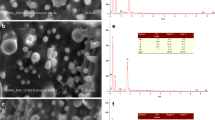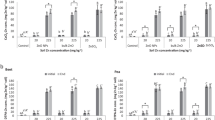Abstract
Zn is an essential element for plants yet some soils are Zn-deficient and/or have low Zn-bioavailability. This paper addresses the feasibility of using ZnO nanoparticles (NPs) as soil amendments to improve Zn levels in the plant. The effects of soil properties on phytotoxicity and Zn bioavailability from the NPs were studied by using an acidic and a calcareous alkaline soil. In the acid soil, the ZnO NPs caused dose-dependent phytotoxicity, observed as inhibition of elongation of roots of wheat, Triticum aestivum. Phytotoxicity was mitigated in the calcareous alkaline soil although uptake of Zn from the ZnO NPs occurred doubling the Zn level compared to control plants. This increase occurred with a low level of Zn in the soil solution as expected from the interactions of Zn with the soil components at the alkaline pH. Soluble Zn in the acid soil was 200-fold higher and shoot levels were tenfold higher than from the alkaline soil correlating with phytotoxicity. Mitigation of toxicity was not observed in plants grown in sand amended with a commercial preparation of humic acid: growth, shoot uptake and solubility of Zn from the NPs was not altered by the humic acid. Thus, variation in humic acid between soils may not be a major factor influencing plant responses to the NPs. These findings illustrate that formulations of ZnO NPs to be used as a soil amendment would need to be tuned to soil properties to avoid phytotoxicity yet provide increased Zn accumulations in the plant.




Similar content being viewed by others
References
Adani F, Genevi P, Zaccheo P, Zocchi G (1998) The effect of commercial humic acid on tomato plant growth and mineral nutrition. J Plant Nutr 21:561–575
Alloway BJ (2009) Soil factors associated with zinc deficiency in crops and humans. Environ Geochem Health 31:537–548
Beyer WN, Green CE, Beyer M, Chaney RL (2013) Phytotoxicity of zinc and manganese to seedlings grown in soil contaminated by zinc smelting. Environ Pollut 179:167–176
Bian SW, Mudunkowotuwa IA, Tupasjngjhe T, Grassian VH (2011) Aggregation and dissolution of 4 nm ZnO nanoparticles in aqueous environments: influence of pH, ionic strength, size and adsorption of humic acid. Langmuir 27:6059–6068
Borill P, Connorton JM, Balk J, Miller AJ, Sanders D, Uauy C (2014) Biofortification of wheat grain with iron and zinc: integrating novel genomic resources and knowledge from model crops. Front Plant Sci 5:53. doi: 10.3389/fpls.2014.00053, 21 Feb 2014
Boussen S, Soubrand M, Bril H, Ouerfelli K, Abdeljaouad S (2013) Transfer of lead, zinc and cadmium from mine tailings to wheat (Tricum aestivum) in carbonated Mediterranean (Northern Tunisia) soils. Geoderma 192:227–236
Cakmak I (2008) Enrichment of cereal grains with zinc: agronomic or genetic biofortification. Plant Soil 302:1–17
Canellas LP, Olivares FL, Okorokova-Façanha AL, Façanha AR (2002) Humic acids isolated from earthworm compost enhance root elongation, lateral root emergence, and plasma membrane H+-ATPase activity in maize roots. Plant Physiol 130(4):1951–1957
Dimkpa CO, Calder A, Britt DW, McLean JE, Anderson AJ (2011) Responses of a soil bacterium, Pseudomonas chlororaphis O6 to commercial metal oxide nanoparticles compared with responses to metal ions. Environ Pollut 159:1749–1756
Dimkpa CO, McLean JE, Latta DE, Manangón E, Britt DW, Johnson WP, Boyanov MI, Anderson AJ (2012) CuO and ZnO nanoparticles: phytotoxicity, metal speciation and induction of oxidative stress in sand-grown wheat. J Nanopart Res 14(9):1125–1129
Dimkpa CO, Latta DE, McLean JE, Britt DW, Boyanov MI, Anderson AJ (2013a) Fate of Cuo and ZnO nano- and microparticles in the plant environment. Environ Sci Technol 47:4734–4742
Dimkpa CO, McLean JE, Britt DW, Anderson AJ (2013b) Antifungal activity of ZnO nanoparticles and their interactive effect with a biocontrol bacterium on growth antagonism of the plant pathogen Fusarium graminearum. Biometals 26:913–924. doi:10.1007/s10534-013-9667-6
Drew MC, Saker LR (1978) Nutrient supply and the growth of the seminal root system in barley. J Exp Bot 29(2):435–451
Fang T, Watson JL, Goodman J, Dimkpa CO, Martineau N, Das S, McLean JE, Britt DW, Anderson AJ (2013) Does doping with aluminum alter the effects of ZnO nanoparticles on the metabolism of soil pseudomonads? Microbiol Res 168(2):91–98
Fernandez D, Garcia-Gomez C, Babin M (2013) In vitro evaluation of cellular responses induced by ZnO nanoparticles, zinc ions and bulk ZnO in fish cells. Sci Total Environ 452–453:262–274
Gavlack RG, Horneck DA, Miller RO, Kotuby-Amacher J (2003) Plant, soil, and water reference methods for the Western region. Western Regional Extension Publications 125, University of California, Davis
Hart JJ, Norvell WA, Welch RM, Sullivan LA, Kochian LV (1998) Characterization of zinc uptake, binding and translocation in intact seedlings of bread and durum wheat cultivars. Plant Physiol 118:219–226
He L, Liu Y, Mustapha A, Lin M (2011) Antifungal activity of zinc oxide nanoparticles against Botrytis cinerea and Penicillium expansum. Microbiol Res 166(3):207–215
Jones DL (1998) Organic acids in the rhizosphere—a critical review. Plant Soil 205:25–44
Jones JB Jr, Case VW (1990) Sampling, handling, and analyzing plant tissue samples. In: Westerman RL (ed) Soil testing and plant analysis, 3rd edn. Soil Sci Soc Am., Inc, Madison
Karakurt Y, Unlu H, Unlu H, Padem H (2009) The influence of foliar and soil fertilization humic acid on yield and quality of pepper. Acta Agric Scand Sect B – Soil Plant Sci 59:233–237
Kairyte K, Kadys A, Luksiene Z (2013) Antibacterial and antifungal activity of photoactivated ZnO nanoparticles in suspension. J Photochem Photobiol B 128:78–84
Kopec DM. Humorous humics: soil amendments worth applying. Univ AZ (2000) Cooperative Extension Turf Tips October 7(10). http://turf.arizona.edu/tipsoct00.htm. Accessed Jan 24, 2014
Li L, Schuster M (2014) Influence of phosphate and solution pH on the mobility of ZnO nanoparticles in saturated sand. Sci Total Environ 472:971–978
Li BY, Zhou DM, Cang L, Zhang HL, Fan ZH, Qin SW (2007) Soil micronutrient availability to crops as affected by long-term inorganic and organic fertilizer applications. Soil Tillage Res 96:166–173
Li M, Pokhrel S, Jin X, Mädler L, Damoiseaux R, Hoek EMV (2011) Stability, bioavailability, and bacterial toxicity of ZnO and iron-doped ZnO nanoparticles in aquatic media. Environ Sci Technol 45(2):755–761
Lin DH, Xing BS (2008) Root uptake and phytotoxicity of ZnO nanoparticles. Environ Sci Technol 42:5580–5585
López-Moreno ML, de la Rosa G, Hernández-Viezcas JA, Castillo-Michel H, Botez CE, Peralta-Videa JR, Gardea-Torresdey JL (2010) Evidence of the differential biotransformation and genotoxicity of ZnO and CeO2 nanoparticles on soybean (Glycine max) plants. Environ Sci Technol 44:7315–7320
Ma JF, Goto S, Tamai K, Ichii M (2001) Role of root hairs and lateral roots in silicon uptake by rice. Plant Physiol 127:1773–1778
Ma X, Gieser-Lee J, Deng Y, Kolmakov A (2010) Interactions between engineered nanoparticles (ENPs) and plants: phytotoxicity, uptake and accumulation. Sci Total Environ 408:3053–3061
Ma H, Williams PL, Diamon SA (2013) Ecotoxicity of manufactured ZnO nanoparticles: a review. Environ Pollut 172:76–85
Malik KA, Azam F (1985) Effect of humic acid on wheat (Triticum aestivum L.) seedling growth. Environ Exp Bot 25:245–252
Martínez C, Yáñez C, Yoon S, Bruns MA (2007) Biogeochemistry of metalliferous peats: sulfur speciation and depth distributions of dsrAB genes and Cd, Fe, Mn, S, and Zn in soil cores. Environ Sci Technol 41:5323–5329
McBeath TM, McLaughlin MJ (2014) Efficacy of zinc oxides as fertilisers. Plant Soil 374:843–855
McBride MB (1994) Environmental chemistry of soils. Oxford University Press, New York, p 339
Milani N, McLaughlin MJ, Hettiaratchchi GM, Beak DG, Kirby JK, Stacey S (2010) Fate of nanoparticulate zinc oxide fertilisers in soil: diffusion and solid phase speciation. In: Soil solutions for a changing world: 19th world congress of soil science, Brisbane, QLD, Australia
Myers SS, Zanobetti A, Kloog I, Huybers P, Leakey AD, Bloom AJ, Carlisle E, Dietterich LH, Fitzgerald G, Hasegawa T, Holbrook NM, Nelson RL, Ottman MJ, Raboy V, Sakai H, Sartor KA, Schwartz J, Seneweera S, Tausz M, Usui Y (2014) Increasing CO2 threatens human nutrition. Nature 510:139–142. doi:10.1038/nature13179
Omar FM, Aziz HA, Stoll S (2013) Aggregation and disaggregation of ZnO nanoparticles: influence of pH and adsorption of Suwannee river humic acid. Sci Total Environ 468–469:195–201
Pedler JF, Kinraide TB, Parker DR (2004) Zinc rhizotoxicity in wheat and radish is alleviated by micromolar levels of magnesium and potassium in solution culture. Plant Soil 259:191–199
Pellet DM, Grunes DL, Kochian LV (1995) Organic acid exudation as an aluminium-tolerance mechanism in maize (Zea mayes L.). Planta 196:788–795
Potters G, Pasternak TP, Guisez Y, Palme KJ, Jansen MAK (2007) Stress-induced morphogenic responses: growing out of trouble? Trends Plant Sci 12:98–105
Priester JH, Ge Y, Mielke RE, Horst AM, Moritz SC, Espinosa K, Gelb J, Walker SL, Nisbet RM, An YJ, Schimel JP, Palmer RG, Hernandez-Viezcas JA, Zhao L, Gardea-Torresdey JL, Holden PA (2012) Soybean susceptibility to manufactured nanomaterials with evidence for food quality and soil fertility interruption. Proc Natl Acad Sci USA 109:E2451–E2456
Richard O, Pineau C, Loubet S, Chalies C, Vile D, Marques L, Berthomieu P (2011) Diversity analysis of the response to Zn within the Arabidopsis thaliana species revealed low contribution of Zn translocation to Zn tolerance and a new role for Zn in lateral root development. Plant Cell Environ 34:1065–1078
Roy RN, Finck A, Blair GJ, Tandon HLS (2006) Plant nutrition for food security: a guide for integrated nutrient management. FAO Fertil Plant Nutr Bull.ftp://ftp.fao.org/docrep/fao/009/a0443e/a0443e.pdf . Accessed 17 July 2013
Russel SR, Sanderson J (1967) Nutrient uptake by different parts of the intact roots of plants. J Exp Bot 18(3):491–508
Spark KM, Wells JD, Johnson BB (1995) Characterizing trace metal adsorption on kaolinite. Eur J Soil Sci 46:633–640
Stevenson FJ (1994) Humus chemistry: genesis, composition, reactions. John Wiley & Sons, New York
Uyusur B, Darnault CJG, Snee PT, Kokën, Jacobson AR, Wells RR (2010) Coupled effects of solution chemistry and hydrodynamics on the mobility and transport of quantum dots nanomaterials in the vadose zone. J Contam Hydrol 118(3–4):184–198. doi:10.1016/j.jconhyd.2010.09.013
Welch RM (1995) Micronutrient nutrition of plants. Crit Rev Plant Sci 14:49–82
Welch RM, Graham RD (2002) Breeding crops for enhanced micronutrient content. Plant Soil 245:205–214
Yang K, Lin D, Xing B (2009) Interactions of humic acid with nanosized inorganic oxides. Langmuir 25:3571–3576
Zandonadi DB, Canellas LP, Façanha AR (2007) Indolacetic and humic acids induce lateral root development through concerted plasmalemma and tonoplast H+ pumps. Planta 225:1583–1595
Acknowledgments
This work was supported by a Grant from the USDA, (USDA-CSREES 2011-03581), the Utah Water Research Laboratory and the Utah Agricultural Experiment Station. Utah Agricultural Experiment Station paper number 8741. We thank undergraduates Melanie Wright, Kjersti Matherson, and Elliot Morrell for their help with the growth studies.
Author information
Authors and Affiliations
Corresponding author
Rights and permissions
About this article
Cite this article
Watson, JL., Fang, T., Dimkpa, C.O. et al. The phytotoxicity of ZnO nanoparticles on wheat varies with soil properties. Biometals 28, 101–112 (2015). https://doi.org/10.1007/s10534-014-9806-8
Received:
Accepted:
Published:
Issue Date:
DOI: https://doi.org/10.1007/s10534-014-9806-8




